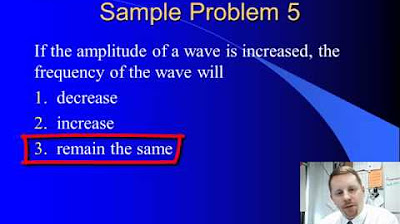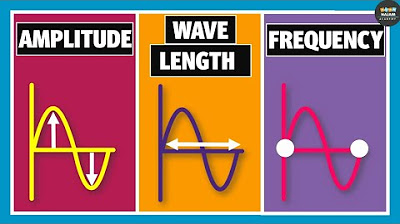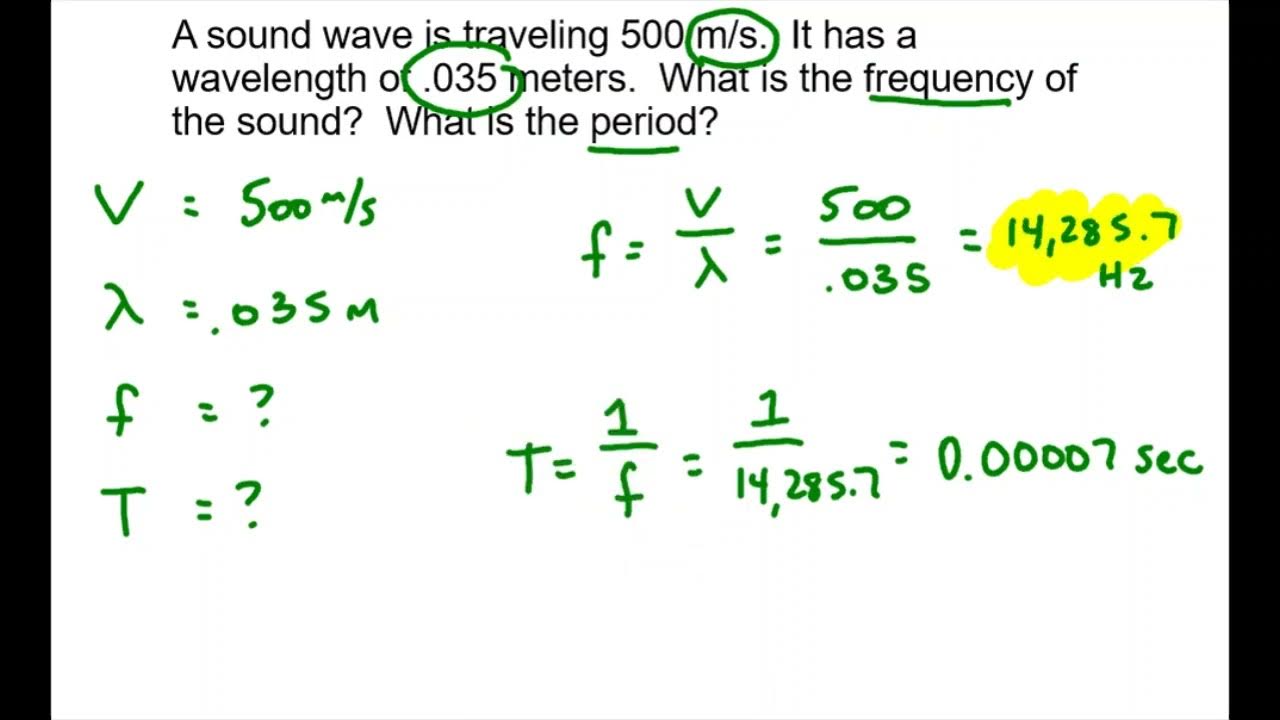Period, Frequency, Amplitude, & Wavelength - Waves
TLDRThis educational video script introduces fundamental concepts of wave properties, including period, frequency, amplitude, and wavelength. It explains these concepts with the help of graphical representations and provides step-by-step instructions on how to calculate each property. The script also includes practical examples and problems to reinforce understanding. Overall, it serves as a comprehensive guide to the basics of wave characteristics and their interrelations.
Takeaways
- 🌊 The period of a wave is the time it takes to complete one cycle, represented by the symbol 'T'.
- 🌊 The wavelength is the distance between cycles, commonly measured in meters.
- 🌊 Amplitude is half the distance between the peak (crest) and the trough of a wave.
- 🌊 Frequency is the inverse of the period, calculated as 1/T, and is measured in hertz (Hz).
- 🌊 The speed (velocity) of a wave is calculated by multiplying the wavelength by the frequency.
- 🌊 To find the period, divide the total time by the number of cycles.
- 🌊 To calculate frequency, divide the number of cycles by the total time in seconds.
- 🌊 Amplitude can be found by taking the maximum value, subtracting the minimum value, and dividing by two.
- 🌊 For a displacement wave, the y-axis typically represents meters or feet, indicating displacement with respect to time.
- 🌊 Given the frequency and speed of a wave, the wavelength can be calculated as the speed divided by the frequency.
- 🌊 The peak-to-peak length of a wave can be used to determine the wavelength, which is half of this distance.
Q & A
What is the period of a wave?
-The period of a wave is the time it takes to complete one full cycle of the wave. It is typically measured in seconds and represented by the symbol 'T'.
How is the period symbolized in notation?
-In notation, the period is symbolized by a capital 'T'.
What is the distance between cycles of a wave called?
-The distance between cycles of a wave is called the wavelength.
What are common units for measuring wavelength?
-Common units for measuring wavelength include meters, feet, and miles, with meters being the most common unit.
What part of the wave is considered the amplitude?
-The amplitude of a wave is the half-distance between the peak (crest) and the trough (bottom part) of the wave.
How is the frequency of a wave defined?
-The frequency of a wave is defined as the inverse of the period, mathematically expressed as 'f = 1/T', where 'f' stands for frequency and 'T' for period.
What is the standard unit for frequency?
-The standard unit for frequency is Hertz (Hz), which is equivalent to one cycle per second (1/s).
How can the speed of a wave be calculated?
-The speed of a wave can be calculated by multiplying the wavelength by the frequency, expressed as 'v = λf', where 'v' is the velocity, 'λ' is the wavelength, and 'f' is the frequency.
How can you determine the amplitude if you know the maximum and minimum values of a wave?
-To determine the amplitude, you take the maximum value, subtract the minimum value, and then divide the result by two. This gives you the amplitude as half the range between the peak and the trough.
Given a wave with a period of 3 seconds, what is its frequency?
-If a wave has a period of 3 seconds, its frequency is 1/3 Hz, or approximately 0.33 Hz.
How can you calculate the wavelength of a wave if you know its frequency and speed?
-You can calculate the wavelength of a wave by dividing the speed of the wave by its frequency, expressed as 'λ = v/f', where 'λ' is the wavelength, 'v' is the velocity, and 'f' is the frequency.
What is the relationship between the peak-to-peak length and the wavelength of a wave?
-The peak-to-peak length of a wave is twice the amplitude. The wavelength, on the other hand, is the distance between two consecutive peaks or troughs. For a simple sinusoidal wave, the wavelength is equal to the peak-to-peak length multiplied by π (pi), as one full cycle includes one peak and one trough.
Outlines
🌊 Introduction to Wave Properties
This paragraph introduces fundamental properties of waves, such as period, frequency, amplitude, and wavelength. It explains that the period is the time taken to complete one cycle of a wave, symbolized by 'T', and is typically measured in seconds. The wavelength is the distance between cycles, commonly measured in meters. Amplitude is the half-distance between the peak (crest) and the trough of a wave. Frequency, the inverse of the period, is represented by 'f' and measured in hertz (Hz). The velocity of a wave is calculated by multiplying the wavelength by the frequency. The paragraph also provides a method to calculate amplitude from the maximum and minimum values of a wave.
📊 Analysis of Wave Graphs
The second paragraph delves into the practical application of wave properties through the analysis of graphs. It describes how to determine the period, wavelength, frequency, and amplitude from a graphical representation of waves. The paragraph clarifies that while the wavelength can be directly measured from the graph, the period and frequency require calculations based on time and the number of cycles. It also addresses a common mistake in the problem setup and explains how to correctly calculate the amplitude for a given wave, using the peak and trough values.
🧮 Calculation of Wave Properties
This paragraph focuses on the calculation of wave properties such as frequency, period, wavelength, and speed. It provides examples of how to calculate these properties using given data. The paragraph explains how to find the frequency of a wave knowing the number of cycles over a certain time period, and how to calculate the period from the frequency. It also demonstrates how to determine the wavelength of a sound wave given its frequency and speed. Additionally, it shows how to calculate the speed of a wave using the wavelength and period, and the frequency using the period. The examples are used to reinforce the concepts and formulas introduced earlier in the script.
Mindmap
Keywords
💡Wave
💡Period
💡Frequency
💡Amplitude
💡Wavelength
💡Crest
💡Trough
💡Velocity
💡Displacement
💡Speed of Wave
💡Equilibrium Position
Highlights
The video discusses fundamental wave properties such as period, frequency, amplitude, and wavelength.
A cycle of a wave is defined as the time it takes to complete one full oscillation.
The symbol for period is capital 'T', and it is commonly measured in seconds.
Wavelength is the distance between successive cycles of a wave and is often measured in meters.
Amplitude is half the distance between the peak (crest) and the trough of a wave.
Frequency is the inverse of the period, calculated as 1/T, with the unit of measurement being Hertz (Hz).
Wave speed can be calculated by multiplying the wavelength by the frequency.
The red wave example demonstrates how to calculate period, frequency, and amplitude from a graph.
The blue wave example illustrates the calculation of wavelength from a graph with meters on the x-axis.
For a wave undergoing 1200 cycles in 5 minutes, the frequency is calculated to be 4 Hz and the period is 0.25 seconds.
A three-kilohertz sound wave traveling at 343 meters per second has a wavelength of 11.43 centimeters.
A wave with a peak-to-peak length of 25 centimeters and a period of 40 milliseconds has a speed of 6.25 meters per second.
The frequency of the wave in the last example is 25 Hz, indicating 25 cycles per second.
The video provides practical applications of wave properties through problem-solving examples.
Understanding wave properties is crucial for various fields, including physics and engineering.
The concepts explained in the video are essential for comprehending wave behavior in different mediums.
The video emphasizes the importance of unit consistency when calculating wave properties.
The relationship between wave speed, frequency, wavelength, and period is foundational for wave analysis.
Transcripts
5.0 / 5 (0 votes)
Thanks for rating:





